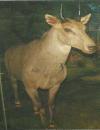Natural History
You are here
Natural History
Introduction:- The term Natural History has come to stand for all that concerns living animals from the lowest type to man himself. Chief object of Odisha State Museum is to help the visitors or readers to see and learn as much as possible about the birds and mammals that are under display in Natural History Section of the Museum. The specimens, vertebrate and invertebrate find place in two spacious halls one of which is exclusively meant for display of mammals in decorated dioramas and the other is beautified with the colourful birds of Indian and Foreign origin.
 |
Indian Bison' (Bos gaurus)The Bison is displayed in a beautifully arranged diorama. The Indian Bison or gaur is the member of the family Bovidae which is the largest of all the wild cattle that live in the hilly forest. The height of the bull at the shoulder is 6ft. Both the sex are of uniform, dark olive-brown colour, but those that habitate in dry and open country are of lighter shades. The ridge on the back of the Bison is... Read More |
 |
Nilgai (Boselaphus tragocamelus)This animal is long-legged with a long head, short neck and a slanted back. The front part of the body is heavier and bulkier than the rear. The head of the female longer and narrower than the male. The head of the male is more compact with a straight nose and a slightly bulging forehead, short, sturdy and steep horns. The slightly bushy tail has a tip like a tussel touching the heels. |
 |
Pangolin or scaly ant-eater (Monis Crassicaudata)Popularly known as `Bajrakif or Bajrakapta is one interesting specimen of the mammal gallery with a broad horny scaled body living on ants. The ventral side of the body is soft with a few bristle hairs. For defence the animal curls itself into an armoured ball. They live in burrows made by themselves. Its feet, 'furnished with long somewhat curved and blunted claws are built for... Read More |
 |
Spotted deer or Chita! (Axis)The spotted deer are seen in attractive habitat show-case. The spotted deer is one of the most beautiful of all deer. Here the spotted deer with his family members are in rhythmic poses. It is reddish brown in colour and profusely dapple with white spots which lasts till the end of life. It stands about 3 feet at the shoulder. The distinguishing characteristic of the deer is its forked antlers,... Read More |
 |
Black buck (Antelope cervicaprd)In the habitat showcase placed next to spotted deer is the black buck from the family Bovidae standing in a beautiful pose. The black buck is the sole representative in India of the genus Antelope. Its beautiful spirally twisted horns spread out from the top of the head in the form of 'V' and its body colour is charming. The height of the buck is 2 to 3 feet with the body weight of 40 Kgs. The body... Read More |
 |
Common otter (Lutra/utra)Is a carnivorous animal associated with acquatic habits. They are characterized by a close coat of water proof fur, thick muscular tail, paddle like feet, larger hind legs and a bristling array of rigid whiskers. They are widely distributed in Northern India and Peninsular region except South India. They live in hollow space beneath the roots of trees on the edge of water tank. |
